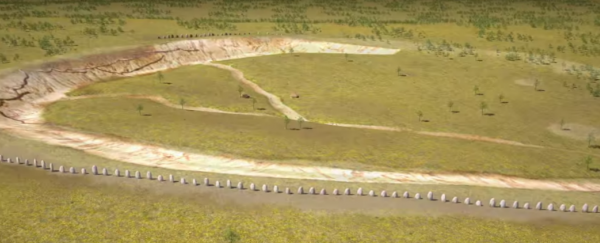A formation of around 90 stone monoliths has been found 3 kilometres northeast of Stonehenge in Wiltshire, Britain, and archaeologists suspect it could be part of the largest Neolithic site ever discovered.
Dated to over 4,500 years old, the sandstone blocks were detected under less than a metre of earth, and scientists in the UK are now using a combination of remote sensing and geophysical imaging technology to construct an underground map of the area. "We don't think there's anything quite like this anywhere else in the world," lead researcher and archaeologist Vince Gaffney from the University of Bradford told BBC News. "This is completely new and the scale is extraordinary."
The monument is located at Durrington Walls, the site of a large Neolithic settlement that could have contained up to 1,000 houses between 2525 and 2470 BC.
Around 30 intact stones reaching about 4.5 m tall have so far been identified, along with the fragments or foundation pits of another 60. Noting its "extraordinary scale", the Stonehenge Hidden Landscapes team behind the discovery has nicknamed the immediate area 'Superhenge', suggesting that it could cover up to five times the area of Stonehenge. They say it could have been constructed at the same time as Stonehenge, or perhaps even earlier.
"What we are starting to see is the largest surviving stone monument, preserved underneath a bank, that has ever been discovered in Britain and possibly in Europe," Gaffney told Ian Sample at The Guardian. "This is archaeology on steroids."
While the stones have yet to be excavated, the researchers have found evidence that they've been shaped like those found in settlements nearby. Named sarsen stones, these sandstone formations have been found throughout Britain, particularly on Salisbury Plain and the Marlborough Downs in Wiltshire, the BBC reports, and it's thought that they were originally carved upright before being pushed over and incorporated into the circular enclosure of Stonehenge. A similar technique could have been employed for the formations at Superhenge.
"All the monuments have a relationship with each other," David Jacques, an archaeologist from from the University of Buckingham, who was involved in the discovery of another formation near Stonehenge called Blick Mead, told the BBC. "So rather than just 'atomising' them and looking at them as individual entities there are deliberate lines of sight or knowledge that things are just over the hill. When you put that together in the late Neolithic - there's something vibrant, exciting and dynamic [about the find]."
The findings were announced yesterday at the launch of the 2015 British Science Festival at the University of Bradford.
